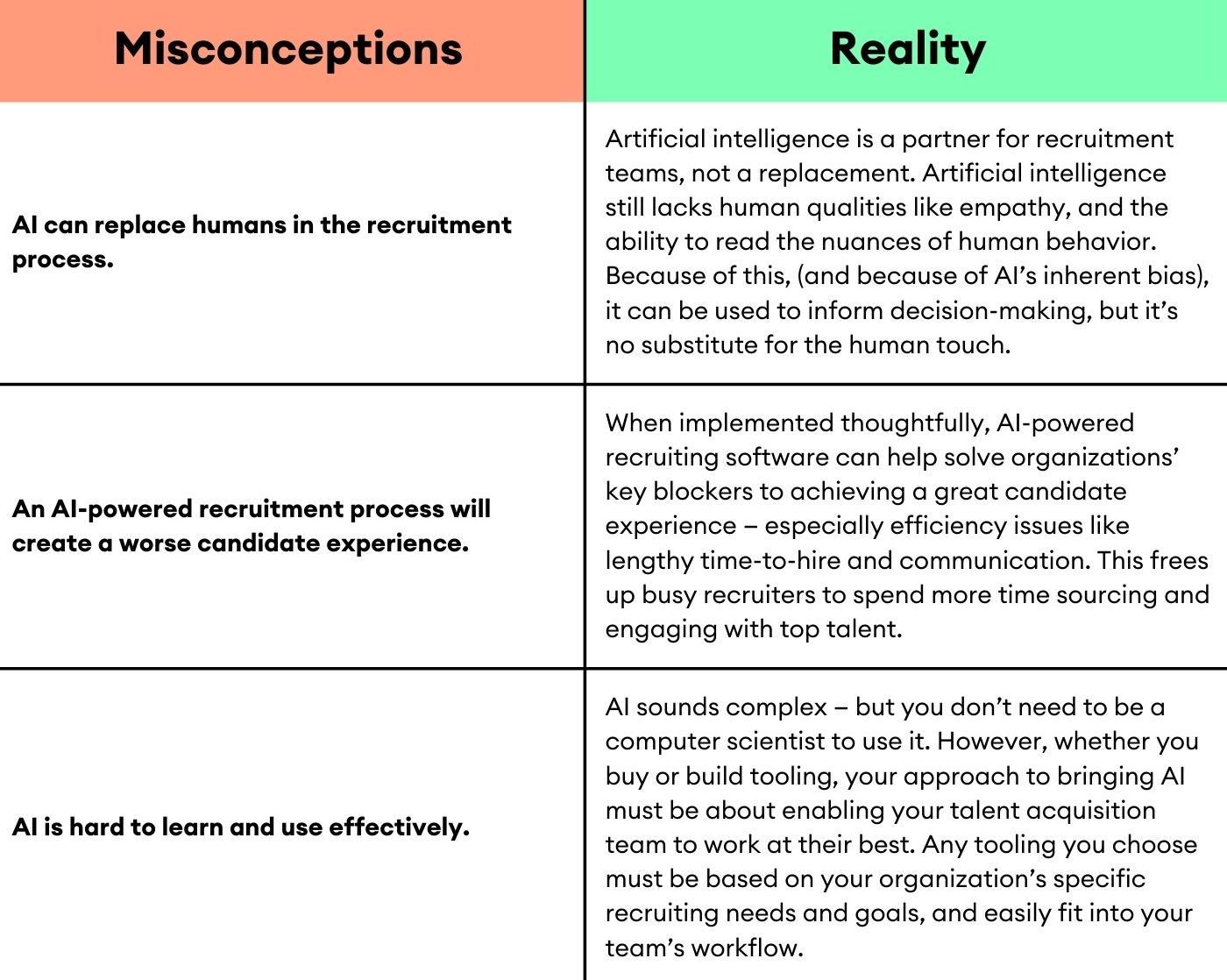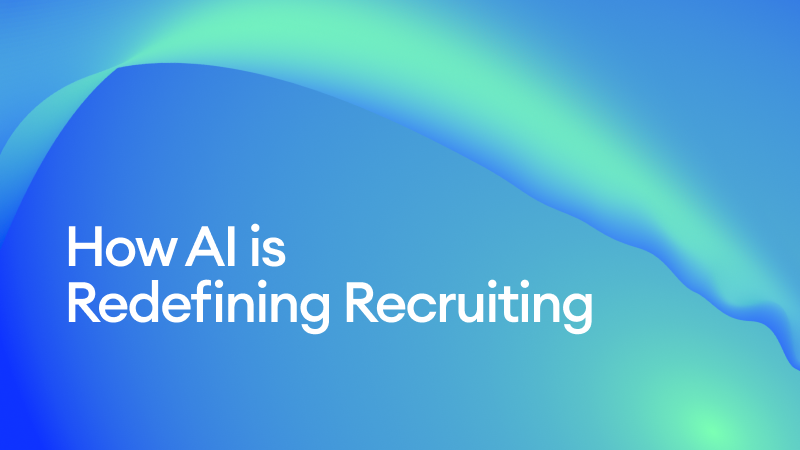Artificial intelligence has catapulted recruiting into a new age. It has the potential to optimize the quality, speed, and accuracy of our ability to recruit new hires, while significantly decreasing the cost and time burden.
81% of talent leaders have already begun exploring this technology. And in years to come, it’s not only going to reshape how you hire, it's going to define your ability to find top talent.
But implementing AI effectively in your organization’s recruitment process to achieve these results depends on understanding the basics of how it works, what it can do, what it can’t do, and some practical applications in the recruiting process.
This guide explores:
- What AI is and its potential uses in recruitment
- Misconceptions about implementing AI in your hiring process
- Potential challenges when using AI tools
- What’s possible with AI right now — and how AI could reshape recruiting in the future
What is AI in recruiting?
AI in recruiting is the use of artificial intelligence technologies like machine learning (ML), natural language processing (NLP), and predictive analytics to improve and accelerate the hiring process. Rather than just storing resumes or scheduling interviews, AI actively analyzes, predicts, and adapts based on data patterns.
In a recruiting context, this can include:
- Screening resumes and job descriptions with NLP to identify specific skills and capabilities.
- Automating repetitive, high-volume tasks like personalizing candidate emails or scheduling interviews.
- Quickly generating job descriptions according to specific hiring criteria.
- Matching candidates to those roles based on their likelihood of success in your specific organization.
- Giving job seekers further details on a role with no need for recruiter assistance.
- Automatically summarizing interview notes for hiring managers, and identifying key discussion topics.
- Providing real-time insights into candidate quality, diversity metrics, and hiring funnel bottlenecks.
The goal isn’t to replace recruiters, but to free up time to build relationships, assess culture fit, and make informed hiring decisions.
AI vs. automation for recruiters
It’s easy to conflate AI with automation in recruiting. We’ve had automated processes for decades, but these have mostly brought small, marginal efficiency gains. Artificial intelligence, on the other hand, is completely redefining recruiters’ day-to-day work.
- Automation = rule-based, repetitive task handling. These tools perform the same task in the same way, every single time. For example: an applicant tracking system (ATS) automatically moves resumes into folders and sends rejection emails once candidates have been screened and denied.
- AI = adaptive, data-driven decision-making. AI offers recommendations and takes actions based on continuous learning and precise context.
For example: an AI-powered screening tool learns from past hiring outcomes to predict which candidates are most likely to succeed in a role.
In short, automation saves recruiters time by removing manual work, while AI makes recruiters smarter by surfacing insights and predictions. When combined, they create a recruiting process that is both efficient and strategic.
Benefits of AI in recruiting
When hiring teams are thoughtful about their application of AI across the recruiting process, it can lead to huge gains in efficiency, accuracy, and quality of hire. Here are just a few of the biggest gains.
1. Increase recruiting efficiency and productivity
With time and resources in short supply, dealing with a deluge of repetitive tasks means recruiters can’t devote their time to finding the best candidates. You’re too often stuck writing reports, updating scorecards, and arranging debrief calls.
Implementing AI for administrative tasks, like screening candidates or entering candidate data, leads to huge efficiency and productivity gains. It also increases the overall accuracy of your work, since manual, repetitive tasks are a key cause of basic human errors.
2. Hire the best candidates, faster
When the recruitment process isn’t optimized for efficiency, it can have a knock-on impact on your quality of hire. AI helps hiring teams maximize access to the right talent by sourcing the most qualified candidates for the role, ultimately speeding up time-to-hire.
The proof is in the results: 69% of HR leaders using AI-powered recruitment software say time to fill is somewhat or much better, while 59% said the same about their quality of hire.
Plus, when recruiters can hire more quickly and efficiently, it reduces the overall cost per hire.
3. Optimize and personalize the candidate experience
There are no second chances for a poor first impression. A bad candidate experience can have a wide-ranging impact, including damage to your employer brand, how engaged they are at work, turnover intention, and even customer satisfaction.
Job seekers often report spotty communication — or no communication at all — as a key hallmark of a poor hiring experience. And this is a bugbear shared by talent acquisition professionals, too: 69% of HR teams report that fixing this issue was their top reason for implementing AI recruiting software.
Integrating AI hiring tools like chatbots can help improve the experience on both sides of the table. They speed up response times at critical hiring stages, provide personalized interactions and information, and increase the number of touchpoints between the candidate and your organization.
4. Structure and synthesize recruiting data
Recruiting relies on conversations. Interviews, feedback sessions, and candidate Q&As are your key sources of primary data. But those exchanges generate unstructured information that’s historically been hard to capture or use. Until recently, most of it slipped through the cracks.
AI changes that. By transforming raw conversations into structured insights, it gives hiring teams access to a far richer picture of each candidate. Instead of relying on scattered notes or selective recall, recruiters can see context that might otherwise be lost.
Because recruiting is so deeply conversation-driven, it’s uniquely positioned to benefit from this capability. AI not only organizes the data but also synthesizes different stakeholder viewpoints into a single, shared perspective. That means fewer blind spots, clearer collaboration, and hiring decisions grounded in a more complete understanding of every candidate.
How AI enhances the recruitment process
Recruitment has always followed a familiar pattern: attract applicants, screen them, interview the best fits, and make informed decisions. Traditionally, much of this work relied on manual effort, spreadsheets, and human judgment. While effective to a point, the process is often slow, inconsistent, and prone to bias.
AI upgrades each stage by adding speed, scalability, and sharper insights. Here’s how it works across the key stages of hiring:
1. Sourcing and screening
Traditionally, recruiters relied on job boards, referrals, and keyword searches in an ATS to identify candidates. Screening was manual, requiring hours spent scanning resumes and cover letters.
But machine learning models can instantly parse thousands of resumes, identify relevant skills, and even predict candidate success based on historical data.
Instead of wading through unqualified applications, recruiters get a short, prioritized list of strong matches in record time.
2. Interviewing and assessment
Interviews have always depended heavily on note-taking and subjective impressions. Feedback is often fragmented, making it difficult to compare candidates consistently.
AI recruiting tools can transcribe, analyze, and summarize interviews, highlighting key themes or skill indicators. Some platforms even support structured video interviews, using natural language processing to evaluate communication skills.
This gives hiring teams a more objective foundation on which to assess candidates and their responses.
3. Candidate engagement
In the past, candidates often waited days for updates, with recruiters juggling back-and-forth emails for scheduling and basic questions. A slow or inconsistent process risked damaging the candidate experience.
Today, conversational chatbots and smart scheduling assistants give candidates immediate answers, 24/7 availability, and seamless interview coordination. This personalization at scale—including tailored job recommendations and timely nudges—keeps candidates engaged and improves the perception of your organization.
4. Data insights and strategy
Hiring decisions have typically been driven by instinct, individual recruiter experience, or siloed metrics (like time to fill). Insights across the funnel were limited, making it hard to identify bottlenecks or measure long-term quality of hire.
But predictive analytics and dashboard visualizations turn recruiting into a data-rich discipline. AI highlights where candidates are dropping out, forecasts hiring needs, and even surfaces bias trends.
The result is a more strategic, evidence-based recruitment process that helps teams continuously improve.
Challenges, risks, and other considerations
According to research by Gartner, organizations are optimistic about an AI-powered future: 68% of company leaders think the benefits of AI outweigh its potential challenges.
But there are some considerations organizations must bear in mind to ensure they get the best outcomes from the technology.
Built-in bias
Artificial intelligence was built by humans, and humans are very prone to unconscious bias. AI can even learn human bias over time.
Because these systems are trained on historical hiring data, they can inherit the same biases that already exist in the workplace. If left unchecked, this can mean favoring candidates from certain backgrounds while overlooking others, ultimately undermining diversity and inclusion goals. The challenge isn’t simply technical — it’s about ensuring the hiring process reflects fairness and equal opportunity.
When implementing AI as part of your recruitment strategy, one big consideration is how and where you apply it so that it doesn’t amplify or perpetuate this bias across your recruiting process. Implementing AI in processes where it has the final say — like interviewing candidates using AI software, for example — should be avoided. AI can be used to inform hiring decisions, but humans must oversee the process and have the final say.
Resistance from recruiters
According to research by Gartner, 76% of recruiters believe that adopting AI is a necessary step. But 60% also feel uncertain on how AI will impact the HR and talent function. AI is always evolving as a technology, which means we’re still testing the limits of what it can do.
And this gap between the urgency to implement AI and uncertainty of what changes it will bring causes misconceptions to take root:

Human perspectives and connections will always be critical in recruiting. AI recruitment tools actually have the potential to unlock this further, by removing much of the busywork and giving recruiters back their precious time.
AI recruitment tools need solid HR data
The success of your AI recruitment strategy depends, at least in part, on your recruitment data to work optimally. It’s the difference, for example, between sourcing candidates by hand, or using a machine learning model that instantly does it for you. One takes hours, the other uses your data to do the same task in seconds based on who you’ve hired in the past.
This makes transparency around usage policies, informed consent, and candidate privacy hugely important.
Limiting the data collected to what’s necessary, anonymizing where possible, and adhering to relevant privacy laws ensures that organizations build trust and avoid regulatory pitfalls. By embedding these practices, you can safely harness the power of AI while maintaining fairness, transparency, and trust.
Tools like Metaview help teams provide this information and collect candidate consent as part of their existing interview scheduling workflow in a scalable way.
Transparency and trust
Many AI-driven systems act as “black boxes,” producing recommendations without clear explanations of how they were reached. For both recruiters and candidates, this can be unsettling.
Hiring managers may hesitate to rely on insights they can’t validate, and candidates may feel skeptical about being evaluated by an invisible algorithm. Without transparency, AI risks eroding confidence rather than enhancing decision-making.
But the right tools can actually improve transparency by making data more available, and leaving fewer decisions to gut feeling or chance.
AI changes require nimble recruiting policies
AI advances are moving fast, and the law is still catching up. While some legislation is already in effect, defining how and where organizations can use AI as part of their hiring process is still a moving target.
Staying in step with legal and industry regulatory requirements is essential. But recruiting teams can also be proactive by implementing an AI policy to help govern best practice internally.
This creates a set of guardrails for all stakeholders involved in the hiring process, and helps recruiting teams focus on their biggest priorities and opportunities to implement AI software.
Best practices for using AI in recruitment
To get the most out of AI in recruiting, organizations need to approach it with clear guardrails and intentional practices.
Use AI with human oversight
AI is excellent at managing scale and surfacing insights. But it can’t (and shouldn’t) replicate the nuance of human judgment or empathy. Recruiters should use AI as a decision-support tool rather than a decision-maker, ensuring that final calls always rest with people.
Monitor and audit AI outputs
Just as hiring managers review human decisions for fairness, AI-driven recommendations should be regularly checked for unintended bias or errors. Structured feedback loops help systems improve over time and ensure accountability remains with the organization.
Without this oversight, teams risk embedding bias or inaccuracies deeper into their processes.
Train and upskill your team
AI tools are most effective when recruiters understand how to interpret the insights and explain them to stakeholders. This doesn’t require technical expertise, but it does mean giving recruiters confidence in using the tools and being transparent with candidates.
Adoption really takes off when teams feel empowered rather than replaced by new technology.
Prioritize the candidate experience
Recruiters should be upfront with candidates about where and how AI is used in the process. Combining automation with meaningful human interactions ensures candidates feel seen and respected, rather than reduced to data points. This not only protects the employer brand, but can become a differentiator in competitive hiring environments.
Ensure data protection and compliance
Legal and ethical principles should underpin every AI deployment. Limiting the data collected to what’s necessary, anonymizing where possible, and adhering to relevant privacy laws ensures that organizations build trust and avoid regulatory pitfalls.
Responsible data use is table stakes for any company wanting to use AI in recruiting responsibly. By embedding these practices, organizations can harness the power of AI while maintaining fairness, transparency, and trust.
The near future for AI in recruiting
When we think about AI’s future relationship with recruiters, it’s tempting to think about it in terms of man versus machine. But if anything, AI helps humans become more human and focus their energy on engaging candidates, instead of time-consuming tasks.
As AI gets more sophisticated, it’s only going to open up more ways for talent acquisition professionals to transform and optimize the recruiting function as a whole.
One major trend is the rise of virtual recruiters. These AI-powered assistants can screen candidates, answer questions, and even conduct structured interviews. Instead of recruiters spending hours on first-round calls, these agents can gather consistent information at scale, leaving hiring teams with richer candidate profiles to work from.
Again, not replacing talent experts. But removing some of the least important tasks from your hectic schedule.
Another area gaining traction is the development of agentic AI in recruitment. Here, intelligent agents collaborate autonomously across the recruitment process. For example, one AI agent may source candidates, another might analyze interview performance, and a third could track hiring pipeline health. All coordinating with each other to optimize hiring outcomes.
This moves AI from a single-tool mindset to a connected ecosystem.
We are also seeing predictive talent analytics become more sophisticated. Rather than simply matching resumes to job descriptions, AI is increasingly capable of forecasting future talent needs, identifying skills gaps, and modeling the long-term success of hires.
In basic terms, recruiting teams are likely to move from a descriptive data analytics model, which analyzes historical data to identify patterns and trends, to more of a predictive and prescriptive one. You could use this across the entire talent lifecycle to:
- Analyze historic tenure data to proactively identify and source talent for upcoming workforce gaps.
- Recommend interview questions to ask to help hiring managers prepare for interviews.
- Predict time to fill and time to hire based on a role’s required skills, location, level, and the job market conditions.
- Suggest ways to engage and communicate with potential candidates based on how they interact with your job advertisements and employer branding.
- Smarter job matching algorithms will mean candidates aren’t just matched to the job requirements, but also to a broader range of candidate attributes and descriptive synonyms.
As organizations adapt to shifting markets, these predictive insights will become a core part of workforce planning.
AI isn’t a “future trend” anymore. It’s rapidly becoming the new normal for hiring teams worldwide.
AI unlocks recruiters at every step
AI is reshaping recruiting from the ground up, transforming a process once driven almost entirely by manual effort into one supported by data, automation, and predictive intelligence. By understanding what AI is, and how it differs from simple automation, you begin to see its value not as a replacement for human expertise, but as an amplifier of it.
AI enhances every stage of the recruitment process:
- Automatically sourcing stronger candidates
- Assessing them more consistently
- Engaging them more effectively
- Making decisions with greater confidence.
But with these benefits come responsibilities. You need to actively guard against bias, maintain transparency, respect candidate privacy, and ensure the human touch persists.
For recruiters, the opportunity is clear: AI can free you from the repetitive tasks that slow you down and give you more time to focus on what matters most: building relationships and making great hires.
And there’s no time like the present. See how Metaview is putting AI at the heart of recruiting today.


